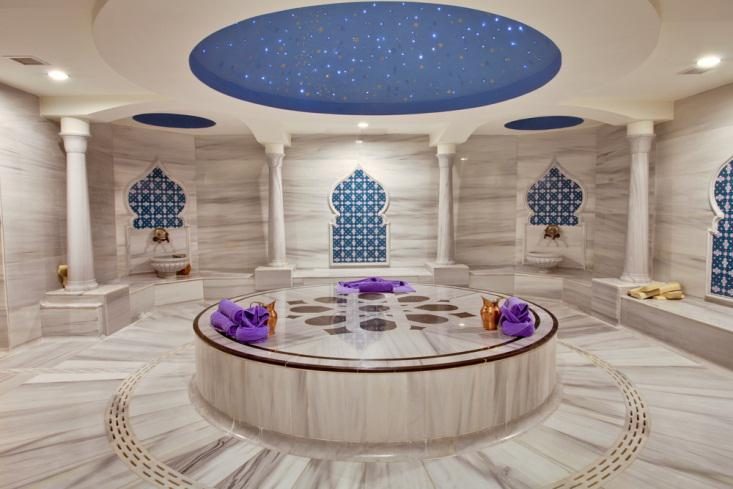Top Turkish Taps: Public Bathing Turkey Style
The Turkish bath is one of the most surprisingly tranquil places to while away the hours. The heat and humidity provide a dense and soothing escape from the hustle and bustle outside the Bath’s doors; the environment is perfect for releasing tension and worry and fostering a feeling of complete relaxation.
While you can find Turkish Baths all over the Mediterranean — and even all over big U.S. cities — there is no place like Istanbul for the real public bathing experience. Here’s a handy guide about Turkish bath etiquette, including what you can expect and what to look for in a top-notch place to bathe publicly.
Pick Your Style
The Turkish bath, or hammam, is essentially a broad, marble room heated and humidified to make you sweat out toxins you’ve accumulated from food or through air — though not all Turkish baths are the same. Traditionally, bathers would seek out a nearby bathing house, be washed by an attendant trained in the healing arts to scrub and massage the toxins and stress out of any body.
However, as Turkish cultures mixed with others, Turkish baths have expanded to include many other services. There are now self-service styles of Turkish baths where bathers supply their own soaps and cloths; this style is much more similar to a sauna one might find at a local gym. Additionally, relaxation practices from other cultures are now available at some Turkish baths, including aromatherapy, reflexology, head massage, and facials.
These non-traditional styles of hammam are typically found in new and modern Turkish baths. Often, you will find that your hotel in Istanbul is affiliated with a Turkish bath that offers this wide range of services to appeal to its international guests. However, the absolute most traditional Turkish baths will only be found in the oldest establishments deep in the heart of Istanbul.
Select Your Hammam
It depends entirely on what you hope to achieve from your bathing experience when it comes to choosing a bath to visit. If you prefer the spa atmosphere replete with facials and aromatherapy, you might try to find an appropriate location in your own city. However, if you want to honestly say you’ve visited a true Turkish bath, you absolutely must head to Istanbul (you can check current ticket prices on sites like Expedia or flights.com).
- Cemberlitash Hammam. One of the oldest baths in the city, this hammam was designed and built in 1584. The architecture is practical and beautiful — studied by bathers and academics alike.
- Galatasaray Hammam. This bath has a surprising legend about its creation concerning a famous poet and respected sultan. It is one of the most popular hammams among locals and tourists.
- Kilic Ali Pasa Hammam. Named in honor of one of Turkey’s most interesting heroes — a slave who became a famous and powerful captain in the army in the 16th century, this bath is as grand as its namesake, with a magnificent dome and ornate decorations.
Seal Your Expectations
While globalization continues to influence hammam culture, long-held beliefs remain in most traditional establishments. This means that men and women are kept completely separate; either a bath will create barriers between male and female areas, or they will impose a curfew, so men and women will come to the bath at different times of day. The reason for this rule is sensible: In the hammam, bathers are barely clothed.
In fact, once you step into your Turkish bath of choice, you will immediately be led into a changing room where you’ll shed your clothing and don a peshtemel, a thin cotton towel to drape around your waist. Most bathers choose to be naked under their peshtemels, but some elect to wear under clothing for decency.
Once you have changed, your attendant (males are called tellaks, females natirs) will lead you into the hot room, where you’ll relax and sweat for 15 minutes or more. This is an excellent time to explore the architecture of the bath if you’ve selected an older hammam, or simply lie on the gobekasht, the central raised platform over the heating source.
After your muscles have become supple, your attendant will rejoin you and begin to lather you with sweet-smelling soaps. During the bathing process, you’ll receive a deep tissue massage to release any remaining tension in the body. After this, your attendant will likely scour your body with an exfoliating pad (you’ll be surprised by the amount of dirt you carry around in your dead skin) and rinse you with shockingly cold water.
At the end of your bath, you can remain in the hot room for as long as you’d like or else visit the “cold” room, filled with showers to help you rinse away any remaining residue and cinch up your open pores. Some hammams offer small cubicles where bathers can nap and snack after their baths, as the ordeal can be rather exhausting, though relaxing.





